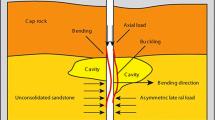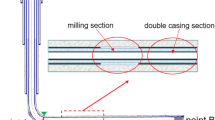Abstract
Casing collapses are frequent events encountered in Iranian oil-producing wells. This phenomenon of casing collapse in wells can reduce and stop oil production. Among the oil fields that witnessed this problem, we have been to the Marun oil field in the southwest of Iran. In south Iran’s oil-rich regions, the Gachsaran Formation has the highest level of plasticity as it contains a large amount of salt units and also exhibits the largest frequency of casing collapse occurrence. The casing collapse occurrence phenomenon might result from the exertion of compression and shear stresses from the formation to the body of casing. In the case of inappropriate cementing, the mentioned stresses are applied in a nonuniform and anisotropic method to the casing. If the respective stresses can overcome the cement strength and then the casing strength, they will make the casing collapse. In the present study, the areas where casing collapse is most likely to happen was determined with the aid of an analytical geomechanical model and by comparing the maximal horizontal stresses against the cement and the casing strengths. Then, via 2-dimensional and numerical simulation of plastic Gachsaran Formation related to the well under analysis by means of the finite-element software ABAQUS, it was attempted to obtain the plastic properties of the formation as well as the numerical values and directions of stresses that might lead to casing collapse occurrence if exerted. The results of the numerical and analytical model indicate the high potential of the plastic Gachsaran Formation in creating a collapse phenomenon. Finally, it was observed that the maximum value of the numerical stresses resulting in the occurrence of casing collapse are along the direction of the maximum horizontal stresses and correspond to the Gachsaran Layer 4–2 possessing the highest salt content.







Similar content being viewed by others
References
Ameen MS, Smart BGD, Somerville J, Hammilton S, Naji NA (2009) Predicting rock mechanical properties of carbonates from wireline logs (a case study: Arab-D reservoir, Ghawar field, Saudi Arabia). Mar Pet Geol 26(4):430–444
Bahroudi A, Koyi HA (2004) Tectono-sedimentary framework of the Gachsaran Formation in the Zagros foreland basin. Mar Pet Geol 21:1295–1310
Bradford IDR, Fuller J, Thompson PJ, Walsgrove TR (1998) Benefits of assessing the solids production risk in a North Sea reservior using elastoplastic modelling. SPE/ISRM rock mechanics in petroleum engineering. Society of Petrolume Engineerig, Trondheim, Norway. https://doi.org/10.2118/47360
Brouard B, Berest P (1999) A tentative classification of salts according to their creep properties. Laboratoire de Mecanique des solides, Ecole Polytechnique, France
Clegg JD (1971) Casing failure study-cedar creek anticline. J Petrol Technol 23(06):676–684
Cristescu N (1994) A procedure to determine nonassociated constitutive equations for geomaterials. Int J Plast 10:103
Dusseaut MB (2004) Drilling through salt: constitutive behavior and drilling strategies. Paper NARMA/ARMA 04-608, Presented at the Gulf Rocks, the 6th North America Rock mechanics symposium, Houston TX
Fairhurst C (1997) Rock mechanics petroleum applications. In: 44th rock mechanic symposium, vol 2, USA
Fredrich JT, Fossum AF (2002) Large-scale three-dimensional geomechanical modeling of reservoirs: examples from California and the Deepwater Gulf of Mexico. Oil Gas Sci Technol Rev IFP 57(5):423–441
Gholami R, Rasouli V, Aadnoy B, Mohammadnejad M (2016) Geomechanical and numerical studies of casing damages in a reservoir with solid production. Rock mech rock eng 49(4):1441–1460
Hayavi TM, Abdideh M (2017) Determination of safe mud pressure window for different well trajectories and stress regimes during drilling operations. Geomech Energy Environ V 12:14–20
Motamedi M, Sherkati S, Sepehr M (2012) Structural style variation and its impact on hydrocarbon traps in central Fars, southern Zagros folded belt, Iran. J Struct Geol 37:124–133
Rahman SS, Chilingarian GV (1995) Casing design theory and practice. Developments in Petroleum Science, vol 42. Elsevier, Amsterdam
Rajabi M, Sherkati S, Bohloli B, Tingay M (2010) Subsurface fracture analysis and determination of in situ stress direction using FMI logs: an example from the Santonian carbonates (Ilam Formation) in the Abadan Plain, Iran. Tectonophysics 492(3):192–200
Rolf B, Mohammed W, Mohsen P (2006) A preliminary study of casing collapse in Iran. Hydroquest report. Schlumberger Oil Company, Houston
Shahbazi K, Abdideh M, Hadipoor M (2017) Modelling hydraulic fracturing process in one of the Iranian southwest oil reservoirs. Appl Earth Sci Trans Inst Min Metall Sect B V 126(3):108–117
Sherkati S, Letouzey J (2004) Variation of structural style and basin evolution in the central Zagros (Izeh zone and Dezful Embayment), Iran. Mar Petrol Geol 21(4):535–554
Veila JDU, Fontoura SAB, Inoue N, Anjos JL (2015) Numerical modelling of casing integrity in salt layers including the effects of dissolution and creep. In 49th US Rock Mechanics/Geomechanics Symposium. American Rock Mechanics Association
Wang HF (2000) Theory of linear poroelasticity. Princenton University Press, Princeton
Yale DP (1994) Static and dynamic rock mechanical properties in the Hugoton and Panoma fields, Kansas. In: SPE mid-continent gas symposium, Amarillo, TX
Zhong L (2008) Deep salt formation wells successfully drilled with integrated techniques in Tahe Oilfield. IADC/SPE 115208
Zoback MD, Barton CA, Brudy M, Castillo DA, Finkbeiner T, Grollimund BR, Moos DB, Peska P, Ward CD, Wiprut DJ (2003) Determination of stress orientation and magnitude in deep wells. Int J Rock Mech Min Sci 40:1049–1076
Zobak MD (2007) Reservoir geomechanics. Cambridge University Press, Cambridge
Author information
Authors and Affiliations
Corresponding author
Rights and permissions
About this article
Cite this article
Abdideh, M., Hedayati Khah, S. Analytical and Numerical Study of Casing Collapse in Iranian Oil Field. Geotech Geol Eng 36, 1723–1734 (2018). https://doi.org/10.1007/s10706-017-0428-0
Received:
Accepted:
Published:
Issue Date:
DOI: https://doi.org/10.1007/s10706-017-0428-0




